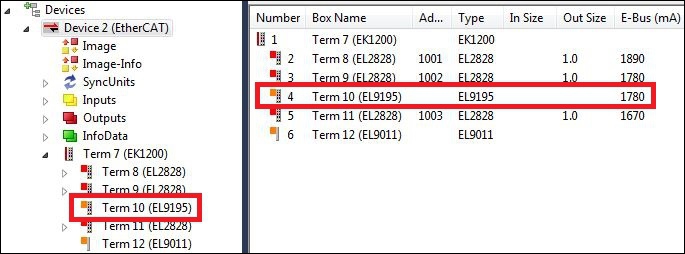Installing passive EtherCAT Terminals
 | Incorrectly installed passive EtherCAT Terminals The E-bus signal between an Embedded PC and the EtherCAT Terminals can be impaired due to incorrectly installed passive EtherCAT Terminals. Passive EtherCAT Terminals should not be installed directly on the power supply unit. |
EtherCAT Terminals that do not take part in active data exchange are referred to as passive terminals. Passive EtherCAT Terminals have no process image and do not require current from the terminal bus (E-bus).
Passive EtherCAT Terminals (e.g. EL9195) can be detected in TwinCAT. In the tree structure the EtherCAT Terminal is displayed without process image, and the value in column “E-bus (mA)” does not change, compared to the preceding EtherCAT Terminal.
 Fig.21: Identifying a passive EtherCAT Terminal in TwinCAT.
Fig.21: Identifying a passive EtherCAT Terminal in TwinCAT.The entry "Current consumption via E-Bus" in the technical data of an EtherCAT Terminal indicates whether a particular EtherCAT Terminal requires power from the terminal bus (E-bus).
The following diagram shows the permissible installation of a passive EtherCAT Terminal. The passive EtherCAT Terminal was not directly attached to the power supply unit.